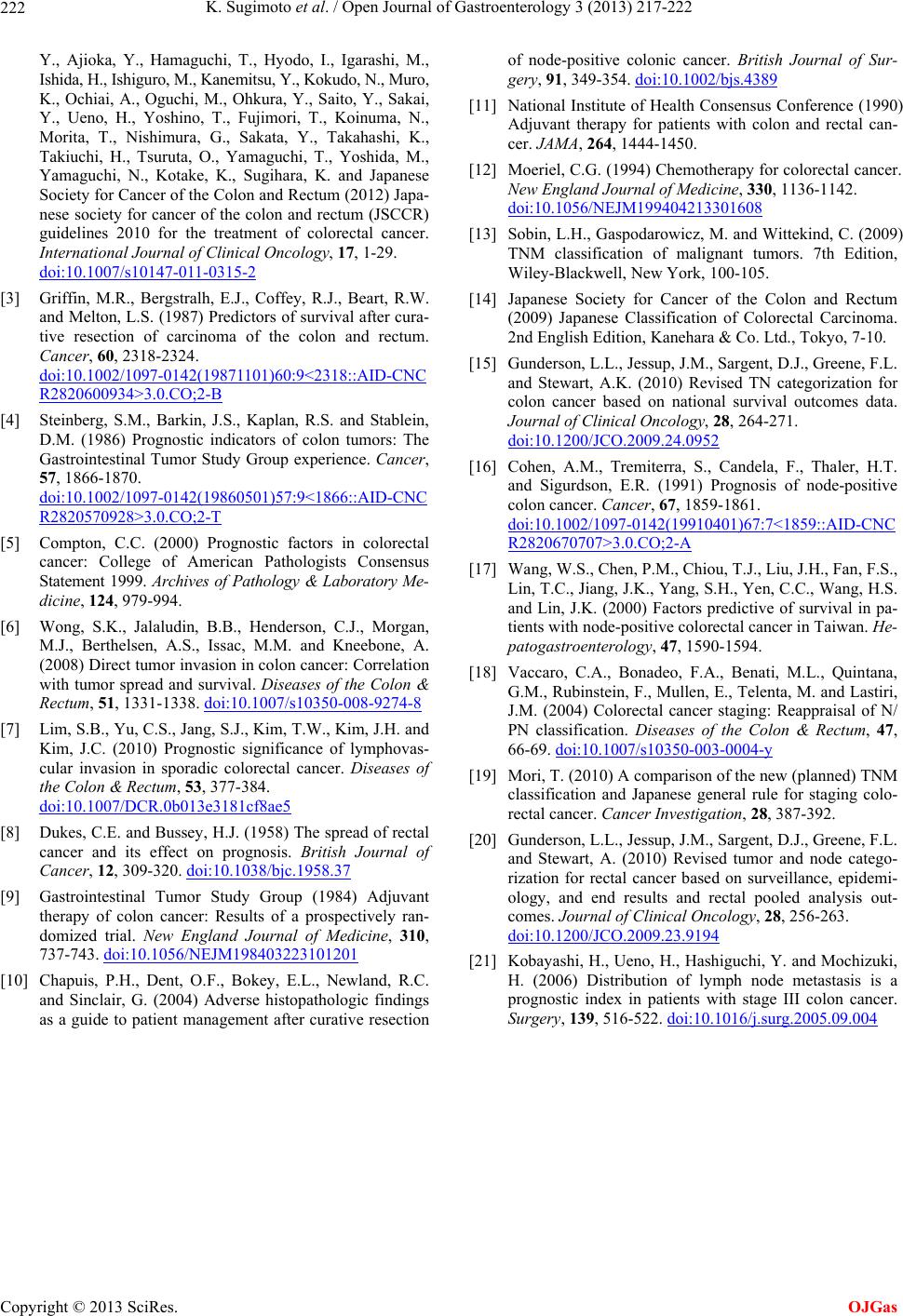
K. Sugimoto et al. / Open Journal of Gastroenterology 3 (2013) 217-222
Copyright © 2013 SciRes.
222
OJGas
Y., Ajioka, Y., Hamaguchi, T., Hyodo, I., Igarashi, M.,
Ishida, H., Ishiguro, M., Kanemitsu, Y., Kokudo, N., Muro,
K., Ochiai, A., Oguchi, M., Ohkura, Y., Saito, Y., Sakai,
Y., Ueno, H., Yoshino, T., Fujimori, T., Koinuma, N.,
Morita, T., Nishimura, G., Sakata, Y., Takahashi, K.,
Takiuchi, H., Tsuruta, O., Yamaguchi, T., Yoshida, M.,
Yamaguchi, N., Kotake, K., Sugihara, K. and Japanese
Society for Cancer of the Colon and Rectum (2012) Japa-
nese society for cancer of the colon and rectum (JSCCR)
guidelines 2010 for the treatment of colorectal cancer.
International Journal of Clinical Oncology, 17, 1-29.
doi:10.1007/s10147-011-0315-2
[3] Griffin, M.R., Bergstralh, E.J., Coffey, R.J., Beart, R.W.
and Melton, L.S. (1987) Predictors of survival after cura-
tive resection of carcinoma of the colon and rectum.
Cancer, 60, 2318-2324.
doi:10.1002/1097-0142(19871101)60:9<2318::AID-CNC
R2820600934>3.0.CO;2-B
[4] Steinberg, S.M., Barkin, J.S., Kaplan, R.S. and Stablein,
D.M. (1986) Prognostic indicators of colon tumors: The
Gastrointestinal Tumor Study Group experience. Cancer,
57, 1866-1870.
doi:10.1002/1097-0142(19860501)57:9<1866::AID-CNC
R2820570928>3.0.CO;2-T
[5] Compton, C.C. (2000) Prognostic factors in colorectal
cancer: College of American Pathologists Consensus
Statement 1999. Archives of Pathology & Laboratory Me-
dicine, 124, 979-994.
[6] Wong, S.K., Jalaludin, B.B., Henderson, C.J., Morgan,
M.J., Berthelsen, A.S., Issac, M.M. and Kneebone, A.
(2008) Direct tumor invasion in colon cancer: Correlation
with tumor spread and survival. Diseases of the Colon &
Rectum, 51, 1331-1338. doi:10.1007/s10350-008-9274-8
[7] Lim, S.B., Yu, C.S., Jang, S.J., Kim, T.W., Kim, J.H. and
Kim, J.C. (2010) Prognostic significance of lymphovas-
cular invasion in sporadic colorectal cancer. Diseases of
the Colon & Rectum, 53, 377-384.
doi:10.1007/DCR.0b013e3181cf8ae5
[8] Dukes, C.E. and Bussey, H.J. (1958) The spread of rectal
cancer and its effect on prognosis. British Journal of
Cancer, 12, 309-320. doi:10.1038/bjc.1958.37
[9] Gastrointestinal Tumor Study Group (1984) Adjuvant
therapy of colon cancer: Results of a prospectively ran-
domized trial. New England Journal of Medicine, 310,
737-743. doi:10.1056/NEJM198403223101201
[10] Chapuis, P.H., Dent, O.F., Bokey, E.L., Newland, R.C.
and Sinclair, G. (2004) Adverse histopathologic findings
as a guide to patient management after curative resection
of node-positive colonic cancer. British Journal of Sur-
gery, 91, 349-354. doi:10.1002/bjs.4389
[11] National Institute of Health Consensus Conference (1990)
Adjuvant therapy for patients with colon and rectal can-
cer. JAMA, 264, 1444-1450.
[12] Moeriel, C.G. (1994) Chemotherapy for colorectal cancer.
New England Journal of Medicine, 330, 1136-1142.
doi:10.1056/NEJM199404213301608
[13] Sobin, L.H., Gaspodarowicz, M. and Wittekind, C. (2009)
TNM classification of malignant tumors. 7th Edition,
Wiley-Blackwell, New York, 100-105.
[14] Japanese Society for Cancer of the Colon and Rectum
(2009) Japanese Classification of Colorectal Carcinoma.
2nd English Edition, Kanehara & Co. Ltd., Tokyo, 7-10.
[15] Gunderson, L.L., Jessup, J.M., Sargent, D.J., Greene, F.L.
and Stewart, A.K. (2010) Revised TN categorization for
colon cancer based on national survival outcomes data.
Journal of Clinical Oncology, 28, 264-271.
doi:10.1200/JCO.2009.24.0952
[16] Cohen, A.M., Tremiterra, S., Candela, F., Thaler, H.T.
and Sigurdson, E.R. (1991) Prognosis of node-positive
colon cancer. Cancer, 67, 1859-1861.
doi:10.1002/1097-0142(19910401)67:7<1859::AID-CNC
R2820670707>3.0.CO;2-A
[17] Wang, W.S., Chen, P.M., Chiou, T.J., Liu, J.H., Fan, F.S.,
Lin, T.C., Jiang, J.K., Yang, S.H., Yen, C.C., Wang, H.S.
and Lin, J.K. (2000) Factors predictive of survival in pa-
tients with node-positive colorectal cancer in Taiwan. He-
patogastroenterology, 47, 1590-1594.
[18] Vaccaro, C.A., Bonadeo, F.A., Benati, M.L., Quintana,
G.M., Rubinstein, F., Mullen, E., Telenta, M. and Lastiri,
J.M. (2004) Colorectal cancer staging: Reappraisal of N/
PN classification. Diseases of the Colon & Rectum, 47,
66-69. doi:10.1007/s10350-003-0004-y
[19] Mori, T. (2010) A comparison of the new (planned) TNM
classification and Japanese general rule for staging colo-
rectal cancer. Cancer Investigation, 28, 387-392.
[20] Gunderson, L.L., Jessup, J.M., Sargent, D.J., Greene, F.L.
and Stewart, A. (2010) Revised tumor and node catego-
rization for rectal cancer based on surveillance, epidemi-
ology, and end results and rectal pooled analysis out-
comes. Journal of Clinical Oncology, 28, 256-263.
doi:10.1200/JCO.2009.23.9194
[21] Kobayashi, H., Ueno, H., Hashiguchi, Y. and Mochizuki,
H. (2006) Distribution of lymph node metastasis is a
prognostic index in patients with stage III colon cancer.
Surgery, 139, 516-522. doi:10.1016/j.surg.2005.09.004